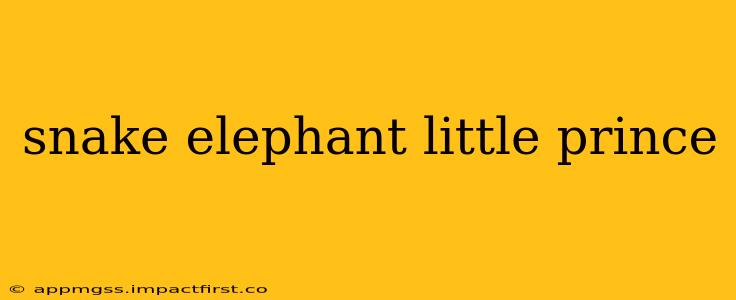The seemingly disparate imagery of a snake, an elephant, and the Little Prince conjures a fascinating blend of symbolism, mythology, and storytelling. While not directly connected in a single narrative, these three elements frequently appear in literature, art, and philosophy, representing distinct yet interwoven concepts. This exploration delves into the individual symbolism of each, exploring their potential intersections and the rich tapestry of meaning they weave together.
What is the Symbolism of a Snake in Different Cultures?
Snakes hold a complex and multifaceted symbolism across diverse cultures. Often associated with danger and deception, they also represent healing, transformation, and rebirth. In some ancient civilizations, snakes were revered as deities, embodying potent forces of nature. The serpent's ability to shed its skin symbolizes renewal and cyclical processes, connecting it to themes of immortality and spiritual awakening. Conversely, the snake's venom can represent poison, temptation, and the destructive aspects of primal instincts. The Little Prince's encounter with the boa constrictor, swallowing an elephant, highlights this duality; the image is initially dismissed as childish, but reveals a deeper layer of meaning about perception and reality.
What Does an Elephant Symbolize in Various Cultures and Mythologies?
The elephant, a majestic and powerful creature, carries significant symbolic weight across various cultures. Its immense size often signifies strength, wisdom, and endurance. In many Asian traditions, the elephant is revered as a sacred animal, associated with royalty, prosperity, and good fortune. The elephant's memory is legendary, representing knowledge, understanding, and the capacity for deep learning. Its trunk, capable of both delicate tasks and immense power, reflects the balance between gentleness and strength. In the context of the Little Prince, the image of the boa constrictor's digested elephant, though seemingly absurd, underscores the limitations of simplistic perception and the vast, often unseen, complexities of the universe.
What is the Little Prince's Significance as a Literary and Philosophical Work?
Antoine de Saint-Exupéry's The Little Prince is a timeless allegory exploring themes of love, loss, responsibility, and the importance of imagination. The seemingly simple narrative belies a profound depth of philosophical inquiry, challenging readers to reconsider their perceptions of adulthood and the complexities of human relationships. The Little Prince's journey across different planets encounters various characters, each embodying a specific human flaw or virtue. These encounters serve as metaphors for the challenges of navigating the human condition. The stark contrast between the simplicity of the Little Prince's worldview and the complexities of the adult world highlights the inherent value of childhood innocence and the importance of preserving wonder and imagination.
What are the main themes of The Little Prince?
The main themes of The Little Prince include the importance of imagination, the nature of love and loss, the responsibility one has towards others, and the distinction between superficial and authentic experiences. The book encourages readers to look beyond the surface, to appreciate the beauty of the unseen, and to reconnect with the childlike wonder often lost in adulthood. It's a powerful reminder of the significance of simple pleasures and the enduring power of human connection.
What are the different symbols in The Little Prince?
The symbols in The Little Prince are numerous and interconnected. The rose symbolizes love and the unique beauty of individual experience. The fox represents the importance of taming and nurturing relationships. The baobab trees represent the destructive nature of unchecked ambition and ego. The different planets visited each represent a different facet of the human condition. These symbols work together to create a rich and multi-layered narrative that continues to resonate with readers of all ages.
How does The Little Prince relate to the snake and the elephant?
The snake and elephant, in the context of the The Little Prince, although not explicitly present in the story in a literal sense, mirror the central themes. The snake's symbolism of both danger and transformation echoes the dangers and transformations the Little Prince faces in his journey. The elephant, swallowed by the boa constrictor, highlights the limitations of simplistic adult perception and the need to recognize the complexity and often hidden truths behind what initially appears simple or childish. The seemingly absurd image acts as a microcosm of the larger philosophical questions explored within the book. It underscores that reality is often far more intricate and nuanced than it initially seems.
In conclusion, the seemingly disparate images of the snake, elephant, and the Little Prince converge to represent the complexities of human experience and the enduring power of imagination, love, and understanding. Their symbolic interplay enriches the narrative, creating a tapestry of meaning that continues to captivate readers and inspire reflection.
